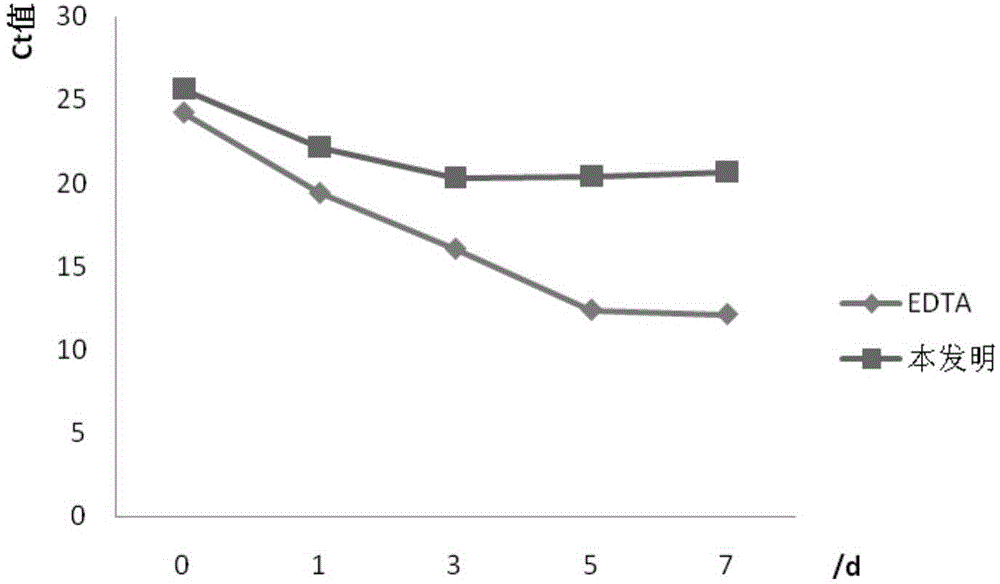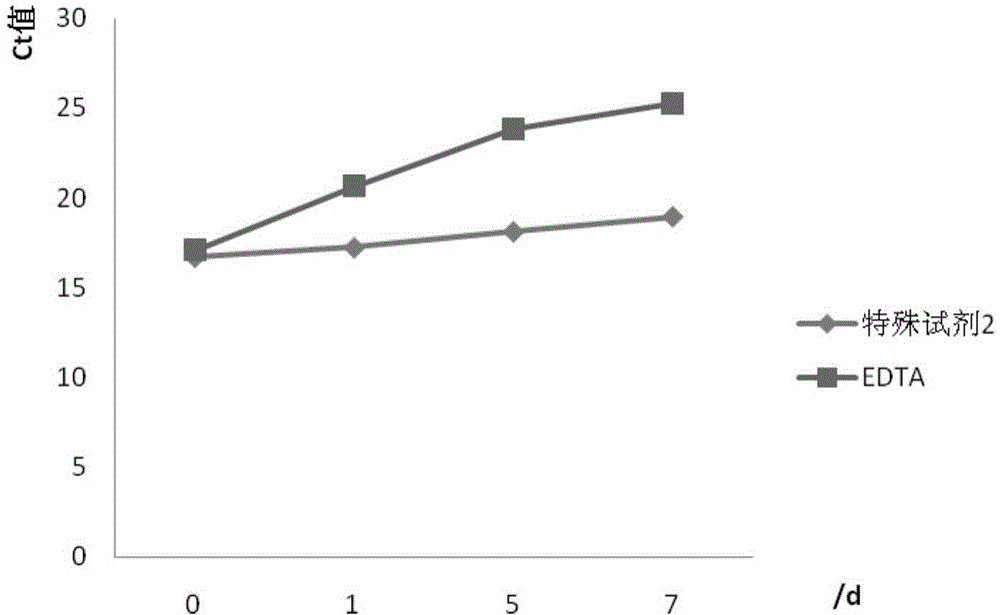A blood anticoagulant used for protecting free DNA and applications thereof
A blood anticoagulant and anticoagulant technology, applied in the field of anticoagulants, can solve the problems of plasma separation, false negative, cell rupture, etc., and achieve the effects of preventing cell rupture, stabilizing the environment, and prolonging the shelf life
- Summary
- Abstract
- Description
- Claims
- Application Information
AI Technical Summary
Problems solved by technology
Method used
Image
Examples
Embodiment 1
[0026] The blood anticoagulant provided in this embodiment is calculated by weight to volume ratio (w / v), wherein the volume is the volume of blood. Contains the following components:
[0027]
[0028] Prepare anticoagulants according to the above components, and conduct a comparative test with common EDTA blood collection tubes. The specific steps are as follows:
[0029] 1. Use EDTA blood collection tubes and blood collection tubes added with the blood anticoagulant provided in this embodiment to collect blood respectively, and the blood collection volume of each tube is 10 mL;
[0030] 2. The collected blood is placed at room temperature, and the blood is gently mixed twice a day by inversion to simulate the transportation environment, so as to observe the changes of blood cells and plasma DNA in the transportation environment.
[0031] 3. Separate the plasma on days 0, 1, 3, 5, and 7; the step of separating the plasma is to put the blood into a centrifuge tube, centrif...
Embodiment 2
[0039] The blood anticoagulant provided in this embodiment comprises the following components by weight to volume ratio (w / v):
[0040]
[0041] Anticoagulants were prepared according to the above components, and compared with common EDTA blood collection tubes, the steps were the same as in Example 1. The results are shown in Table 2 and figure 2 shown.
[0042] Table 2 The present invention and common EDTA blood collection tube comparative test 2
[0043]
[0044] It can be seen from Table 2 that the Ct value after using the present invention for 7 days is close to the data on the 0th day, while the blood in the common EDTA blood collection tube increases with the storage time, and the difference between the Ct value and the data on the 0th day gradually increases. It can be seen that the use of the present invention can effectively guarantee the blood quality, and is beneficial to subsequent operations such as DNA extraction.
Embodiment 3
[0046] The blood anticoagulant provided in this embodiment comprises the following components by weight to volume ratio (w / v):
[0047]
[0048] Prepare anticoagulants according to the above components, and conduct a comparative test with ordinary EDTA blood collection tubes. The specific operation steps are as follows:
[0049] 1. Use EDTA blood collection tubes and blood collection tubes added with the blood anticoagulant provided in this example to collect blood respectively. The blood collection volume of each tube is 10 mL, and 2.25 μg of mutation-positive tumor cell line DNA is added to the blood;
[0050] 2. The collected blood is placed at room temperature, and the blood is gently mixed twice a day by inversion to simulate the transportation environment, so as to observe the changes of blood cells and plasma DNA in the transportation environment.
[0051] 3. Separate the plasma on days 0, 1, 5, and 7; the step of separating the plasma is to put the blood into a cent...
PUM
 Login to View More
Login to View More Abstract
Description
Claims
Application Information
 Login to View More
Login to View More - R&D
- Intellectual Property
- Life Sciences
- Materials
- Tech Scout
- Unparalleled Data Quality
- Higher Quality Content
- 60% Fewer Hallucinations
Browse by: Latest US Patents, China's latest patents, Technical Efficacy Thesaurus, Application Domain, Technology Topic, Popular Technical Reports.
© 2025 PatSnap. All rights reserved.Legal|Privacy policy|Modern Slavery Act Transparency Statement|Sitemap|About US| Contact US: help@patsnap.com



